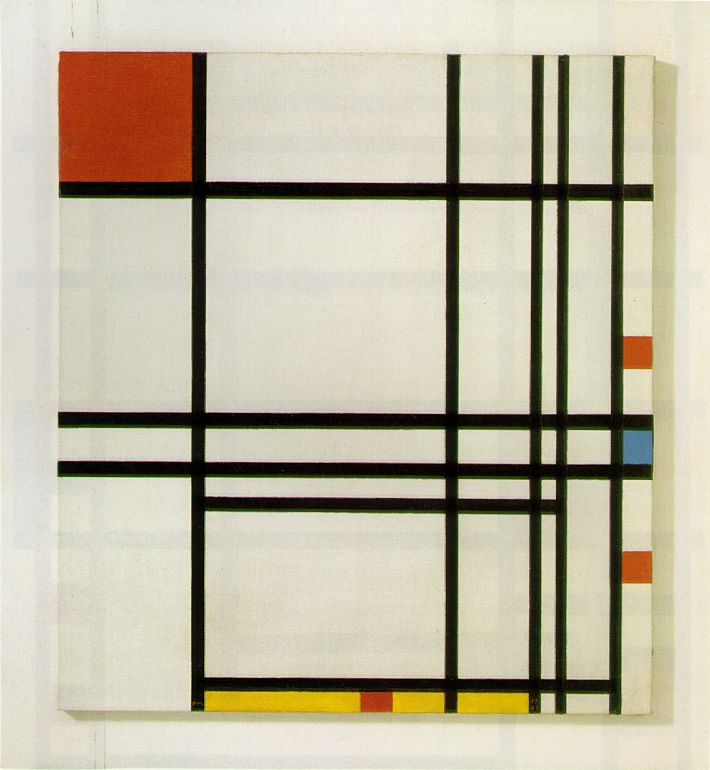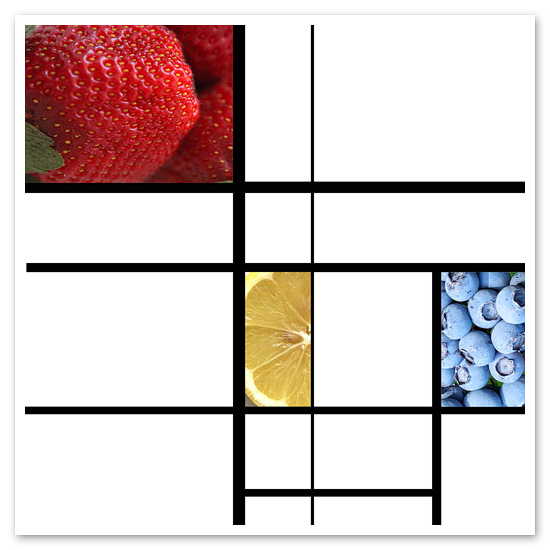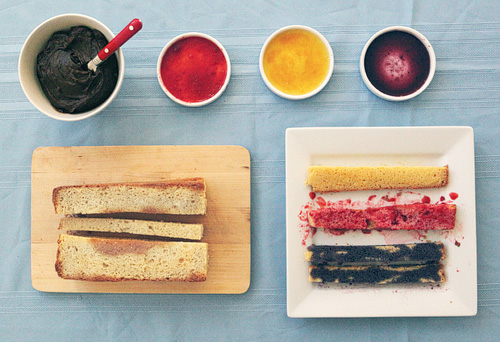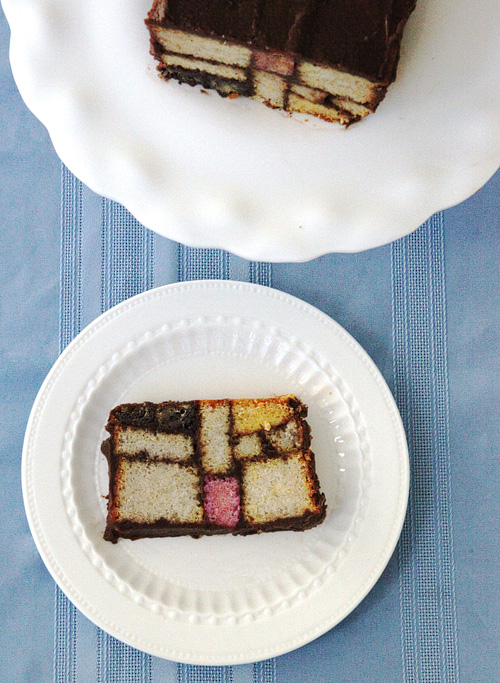This post is inspired by Caitlin Williams Freeman’s Mondrian Cake from the cafe at the San Francisco Museum of Art. I wanted my version to be easily recreated in any home kitchen. The cake was delicious but there are a few things I will change the next time I try this recipe. First, I will use angel food cake rather than pound cake – I think it would better absorb the natural food coloring and not appear so yellow. Secondly, I will try mixing the berry juices into the batter to see if I can achieve an even stain. Although the slice of cake pictured below turned out pretty even, my results throughout the rest of the cake were spotty at best. Finally, I would wrap the outside in fondant to hold all of the segments together. Using the natural food colorings will not achieve the bright results found in Freeman’s cake but it does provide a pretty tasty way to insert a bit a flavor into each slice.
The painting recreation was inspired by Bridget from The Way the Cookie Crumbles.

The canvas Composition No. 8 (1939-42) was painted during Piet Mondrian’s time in London and New York where he fled from Paris because of the invading fascist forces. Mondrian worked within rigid self-imposed artistic restraints. Typically he only painted using primary colors and straight sided forms. He founded the De Stijl movement (Dutch for ‘The Style’) which had a profound influence on modern and abstract art. His later paintings feature more lines than the earlier works and have been likened to cartographic maps. During this period, the blocks of color were not habitually contained by the black lines and were instead allowed to ‘float’ freely upon the white space. Mondrian developed the idea of a ‘dynamic equilibrium’ evident through the relationships and patterns of the blocks and lines (1). The composition is not balanced, with more visual activity on the right side of the canvas. This however, is compensated by the inclusion of the large red square in the top left which is then stabilized by the strip yellow at the bottom center of the painting. There is no reason to the rhyme but Mondrian includes enough impetus to carry the eye over the entire surface of the canvas.

Traditionally, pound cake was made with a pound each of flour, butter, eggs, and sugar (hence the name). Often the ratio is paired down to make smaller cakes with additional ingredients added depending on the regional origin of the recipe. The British variation contains dried fruits and yields a very dense cake. My recipe, because of the inclusion of lemon zest, would be closer to the French version called quatre-quarts which features fresh lemon juice. The most favored recipe is the sour cream pound cake found in the United States (2). The sour cream addition makes for a wonderfully moist cake with a very delicate crumb.

Mondrian Pound Cake
Pound cake recipe adapted from Good Taste – April 1998
Yield: 8 servings
9 ounces butter, room temperature
1 cup superfine sugar
1 teaspoon vanilla extract
1 teaspoon lemon zest
4 large eggs whites + 2 yolks
1 2/3 cups all-purpose flour
3 teaspoons baking powder
Preheat the oven to 340°F/170°C. In a large bowl begin to beat the butter with an electric mixer until it is smooth, 2 to 3 minutes. Add the sugar, vanilla extract, and lemon zest and continue to beat until creamy, 5 minutes. Add the four eggs, one at a time and continue to beat the mixture between each addition, about 1 minute each time.
Sift the flour and baking powder into the mixture and gently fold until well combined. Spoon the mixture into a bread tin and after smoothing the top of batter, bake for 50 minutes or until a testing skewer comes out clean. Remove from pan and cool for 20 minutes.
Assembly: Prepare frosting and natural food colorings (see below). Slice the cake into strips of varying sizes lengthwise, paying attention to the order in which the cake was dismantled (it will be helpful to remember for a quick and painless assembly). Select three strips of cake to be stained and poke throughout with a toothpick to allow the berry juices to penetrate the middle of the cake. On a large plate drizzle all of the sides of each strip of selected cake with the berry juice. Be careful not to over-soak the cake and make it soggy. Allow to dry slightly before assembly for 5 to 10 minutes.
Place a piece of parchment paper on the cake platter. On the first strip of cake to form the base, cover all sides with the chocolate icing. Lay the next strip down and repeat the process effectively gluing the cake back together with the icing. Once the cake is reassembled, coat the outside with the remaining chocolate frosting. Before serving place in the freezer for about 20 minutes to set the frosting and to keep the segments together. Will keep for 2 to 3 days refrigerated.

Chocolate Frosting
adapted from Hello, Cupcake!
1 stick butter, cubed
2/3 cup chocolate, chopped
450 grams icing sugar
1/3 cup milk
Melt the butter and the chocolate stirring often. Pour the mixture into a large mixing bowl and beat with an electric mixer.
Add the icing sugar alternatively with the milk. Continue beating until smooth.
Natural Food Coloring
Red: Finely grate two strawberries.
Blue: Boil 1/2 of a pint of blueberries until the juice is released.
Yellow: Add 1/3 tsp turmeric to the juice from half of a lemon.

76 comments
Σπύρος Βάθης (@svathis) says:
May 13, 2011
Α!, βρήκαμε και την συνταγή για το επικό Mondrian Cake (thnx 2 @MoiraineM) http://bit.ly/lOJqLS
Beana Bern (@2beanornot2bean) says:
May 13, 2011
this makes me want to bake http://www.feastingonart.com/2009/08/mondrians-pound-cake.html
rachel says:
May 19, 2011
i saw this cake on food network… they used white cake, not pound cake, which makes for better coloring. also, they used a ganache, not frosting. i think those two tweaks can make this cake even better! but you did an amazing job! makes me want to try.
nina boccia (@nboccia) says:
Jul 4, 2011
Mine: Feb 13. RT @ashley_bartlett My birthday is on Oct 13. RT @SFMOMA A decent DIY Mondrian cake recipe! http://t.co/XEDX4aS (@m_liddament)
Catherine Mock (@catherinegmock) says:
Jul 4, 2011
@laurenetchells can we somehow make this, please? http://t.co/kH4Nv00 #mondrian #cake
Jung Youn Yim (@purinie) says:
Jul 4, 2011
Piet Mondrian – Pound Cake http://t.co/CMwGDCH nice try and yammy interpretation
Devon Renee Plopper (@DevonsRedSpecs) says:
Jul 5, 2011
@korenaapffel This…is pretty cool. I’m thinking potential birthday cake cool. http://t.co/DsqRexm
Hatsy T (@HatsyT) says:
Jul 5, 2011
and the recipe … RT @SFMOMA: Finally, a decent DIY Mondrian cake recipe! http://bit.ly/jr4FHU via @m_liddament
Mondrian Cake – San Francisco MOMA « montivagant says:
Jul 10, 2011
[…] if you’re interested in making your own (which I hope I get a chance to one day), visit http://www.feastingonart.com for the […]
charlotte.davies$$ says:
Aug 13, 2011
this is soo creative i luv it!!<3
LES (@lesfotoescola) says:
Aug 31, 2011
Modernismo ao forno! Confira o belo trabalho de Piet Mondrian. http://t.co/11UoQWv
leslie says:
Dec 12, 2011
Love this!!
Bolo de Mondrian | Enfimblog says:
Jan 19, 2012
[…] Megan Fizell prepara seu cardápio inspirada em obras de arte. Os pratos preparados em seu restaurante refletem a figura de pinturas inesquecíveis na gastronomia. Exemplo disso você confere no Mondrian reinventado no bolo. […]
Haggadot.com (@Haggadot) says:
Mar 2, 2012
Piet Mondrian Cake?! Time to rethink those Passover rainbow cookies into something a little more modernist… http://t.co/T801sFL0
Minna Hong (@asiangrrlMN) says:
Mar 2, 2012
@DeeLoralei Found it! http://t.co/s1s5iGkx
Rebecca Merry (@RebeccaJMerry) says:
Mar 8, 2012
make your own mondrian cake http://t.co/MBCxJBt7
Modernismo no forno | Entre Panelas e Tigelas says:
Mar 15, 2012
[…] um blog “fofucho” que publica receitas, quem quiser aprender a fazer essa obra de arte, clique aqui. Vale a […]
Damien Hirst's Shark (@Hirst_Shark) says:
Apr 24, 2012
I’d like a slice (the size of an actual Mondrian) RT @morrismuseum: Let them eat cake: the Mondrian pound cake http://t.co/C7tnxQBL
Bendito (@BenditoLabs) says:
May 22, 2012
#inspiracion #merienda Ponqué inspirado en Piet Mondrian, sin colores artificiales — http://t.co/8KERQvl2 (via @morrismuseum)
Gaby (✿◠‿◠) (@GABRIELLALARIOS) says:
Jun 8, 2012
Thank you google for never failing me, I just found out how to make a Mondrian cake @Paula_Abarca http://t.co/ENHB7YwQ
@mjr1961 says:
Dec 9, 2012
@CatrienKetting Je meende het echt? LOL. Succes! http://t.co/DI7gNMny http://t.co/Ow03iOpW
Sobre los blogs de cocina | Blog de Cuadrivio says:
Dec 31, 2012
[…] [4] <http://www.feastingonart.com/2009/08/mondrians-pound-cake.html>. […]
@das_salz says:
Jan 21, 2013
Wir backen uns einen Mondrian-Kuchen ►►http://t.co/owDBvhDh #kochen #backen #kuchen #rezept #kunst #art
http://www.cakeboys.com.au says:
Apr 9, 2013
This is the third time I’ve been to your website. Thanks for explaining more details.
Anteo Hotellerie Restauration says:
May 26, 2015
[…] Et voilà le cake Mondrian, servi au café du musée d’art moderne de San Francisco, le sfmoma. Et pour la recette, de l’idée ici […]
Creative Cooking With These Works Of (Edible) Art - Verus Art says:
Nov 21, 2017
[…] This cake, inspired by the Mondrian, was recreated by Megan Fizell. Mondrian has many composition numbers, so it is up to you how you would like to style this cake! This recipe used natural food dye with fruit, however; the natural food die could be subbed with food colouring if you wanted to get a more vibrant colour. We think this one is great if you want to experiment a little and have fun trying different techniques – isn’t that what art is all about? Check out the full recipe here. […]